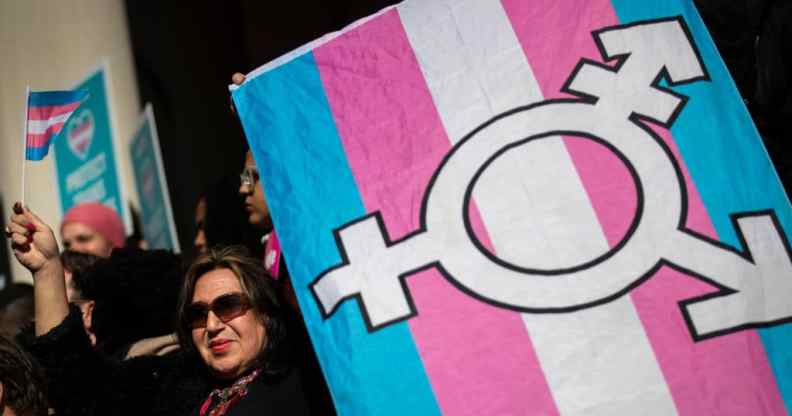No, offering breast binders to trans kids isn’t ‘child abuse’

Activists and their supporters rally in support of transgender people on the steps of New York City Hall, October 24, 2018. (Drew Angerer/Getty)
Activists and their supporters rally in support of transgender people on the steps of New York City Hall, October 24, 2018. (Drew Angerer/Getty)
An article which questioned whether breast binders for trans youth are a form of “child abuse” has been condemned by trans advocacy groups.
The article, published by The Telegraph on Tuesday (27 September), referenced a page on the Metropolitan Police’s website which provides information on the abusive practice known as “breast ironing”.
According to the National FGM Centre, breast ironing is largely practiced in parts of Africa by families trying to prevent pregnancy and rape, and deter unwanted attention from men.
“In some families, large stones, a hammer or spatula that have been heated over scorching coals can be used to compress the breast tissue,” the National FGM Centre says.
“Other families may use an elastic belt or binder to press the breasts so as to prevent them from growing.”
When The Telegraph published another article about breast binding – in which a reporter pretended to be a 14-year-old trans boy, and reportedly received a binder from charity Mermaids – anti-trans campaigners, and other people misled by the report, started questioning on social media how the affirming practice differs from breast ironing.
Ian Acheson, a former Home Office official and a professor at Staffordshire University School of Law, tweeted: “I’m really confused. Is this not ‘child abuse’ if the same process is advocated by a UK registered charity acting in collusion with a minor against the wishes of parents?”
In its piece, The Telegraph conflated breast ironing with breast binding, suggesting it could be seen as “child abuse” to provide a binder to a person under the age of 18.
Breast ironing and binding are not the same thing
However, breast ironing and binding are entirely separate practices.
Breast ironing is widely regarded as an abusive practice that is usually forced upon a child against their will, whereas binding is often used by trans and non-binary people to ease their own gender dysphoria.
According to Childline, breast ironing – or flattening, as it’s also called – is used to “flatten” a person’s breasts and delay their development.
“This is different from choosing to bind your breasts,” the charity notes.
Childline also states some young people will use binders to hide parts of their bodies that cause them discomfort.
“It’s important to remember that these can sometimes be uncomfortable or dangerous, and that you should speak to a doctor before using them,” the charity says.
The Telegraph‘s article led to outcry from trans advocacy groups and from the trans community on social media, with many condemning the newspaper for conflating breast ironing with breast binding.
Breast binders: ‘A successful harm reduction programme’
Cleo Madeleine, communications officer with trans charity Gendered Intelligence, told PinkNews that The Telegraph‘s article is “nonsense”.
She says the piece is part of a “concerted effort” in the right-wing press to drag trans youth charity Mermaids “through the muck”.
“There’s a reason this piece has come here and now, and we’ve got absolutely no patience for it.
“Basically what The Telegraph is saying is that Mermaids shouldn’t be [providing binders] and that they’re causing harm, but it’s actually an enormously successful harm reduction programme, and if they seriously cared about child welfare they’d recognise that.”
Madeleine adds it’s “totally bogus” for The Telegraph to suggest that a trans minor using a binder could be a matter for the police – however, she says it’s a “familiar narrative” for the trans community.
“It’s something that we’re seeing increasingly here, this reframing of harm reduction as abuse and then attempting to have that ‘abuse’ prosecuted.”
“There’s no way this could be seen as abuse, it’s totally ridiculous.
“This isn’t about introducing anything new to young people. It’s about taking young people who are suffering with gender dysphoria and helping them to be comfortable.”
Trans people and allies also questioned The Telegraph‘s approach on social media.
So the latest anti-trans story in the media tries to conflate how the police handle breast ironing, which is an abusive practice forced onto kids by their parents, and binders for trans boys, which are not. The police know the difference, so does the law, so does everyone else
— Katy Montgomerie 🦗 (@KatyMontgomerie) September 28, 2022
Binding and breast ironing are not the same thing at all. Binding doesn’t alter the tissue permanently, it just changes the shape while wearing it. The entire point of mermaids sending them out along with info about how to use them safely is to avoid the risks listed here.— Goth Disco Gnome Blocked Elon again (@MrCrystalMighty) September 27, 2022
a teen who wants a flatter looking shape and wants to wear a binder safely in order to do that with minimal harm or risk to themselves out of their own discomfort is not the same thing as someone forcefully flattening their child's chest in order to fit in with society.— psychic contagion (@notCursedE) September 26, 2022
Contrary to The Telegraph‘s article, breast binding is a common practice for many trans, non-binary and gender non-conforming people.
Studies have shown, when done correctly, binding can help alleviate gender dysphoria, or simply make a person feel more comfortable in their skin.
The current furore over breast binders started when The Telegraph ran a story about an adult posing as a 14-year-old trans boy who was reportedly offered a binder by Mermaids.
Following the publication of that article, Mermaids said in a statement that binding can help to “alleviate” a trans person’s distress.
“Mermaids takes a harm reduction position with the understanding that providing a young person with a binder and comprehensive safety guidelines from an experienced member of staff is preferable to the likely alternative of unsafe practices and/or continued or increasing dysphoria.
“The risk is considered by Mermaids staff within the context of our safeguarding framework.”
PinkNews has contacted The Telegraph for comment.

